Hilton's Hospitality Business Strategy: Competitive Edge Analysis
VerifiedAdded on 2023/06/09
|13
|3802
|180
Report
AI Summary
This report provides a comprehensive analysis of Hilton's hospitality business strategy, focusing on its competitive environment and strategic directions. It begins by examining the impact of the macro-environment using PESTLE and SWOT analyses, followed by an internal analysis of Hilton's capabilities using McKinsey's 7S framework. The report then applies Porter's Five Forces model to evaluate competitive forces and suggests relevant tactics to improve Hilton's competitive edge and market position. Furthermore, it evaluates different strategic directions available to Hilton, recommending the most appropriate growth strategy based on the Ansoff Matrix. The analysis includes strategic planning with tactical objectives and a competitive analysis to produce valid strategic directions, ultimately concluding with key insights for Hilton's strategic management.
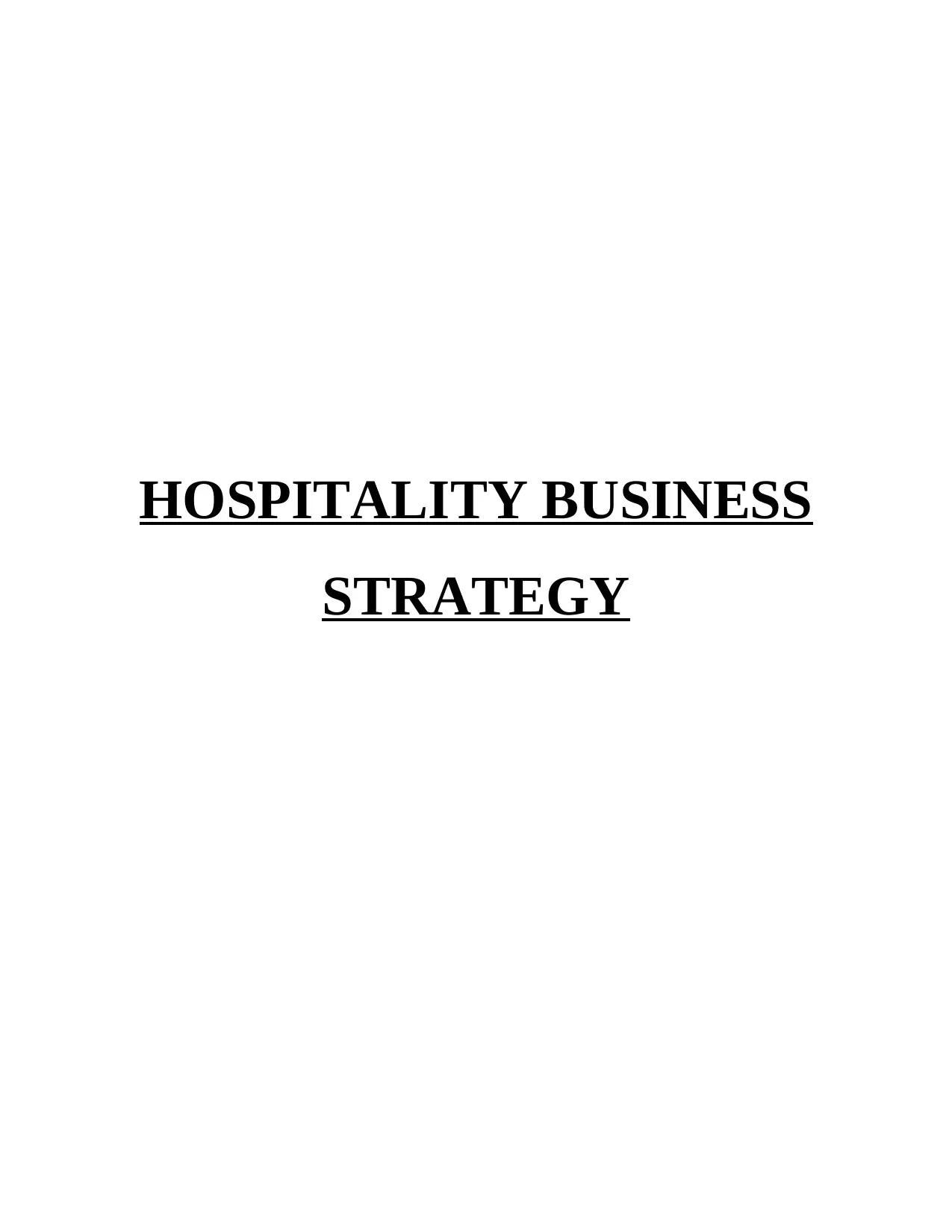
HOSPITALITY BUSINESS
STRATEGY
STRATEGY
Paraphrase This Document
Need a fresh take? Get an instant paraphrase of this document with our AI Paraphraser
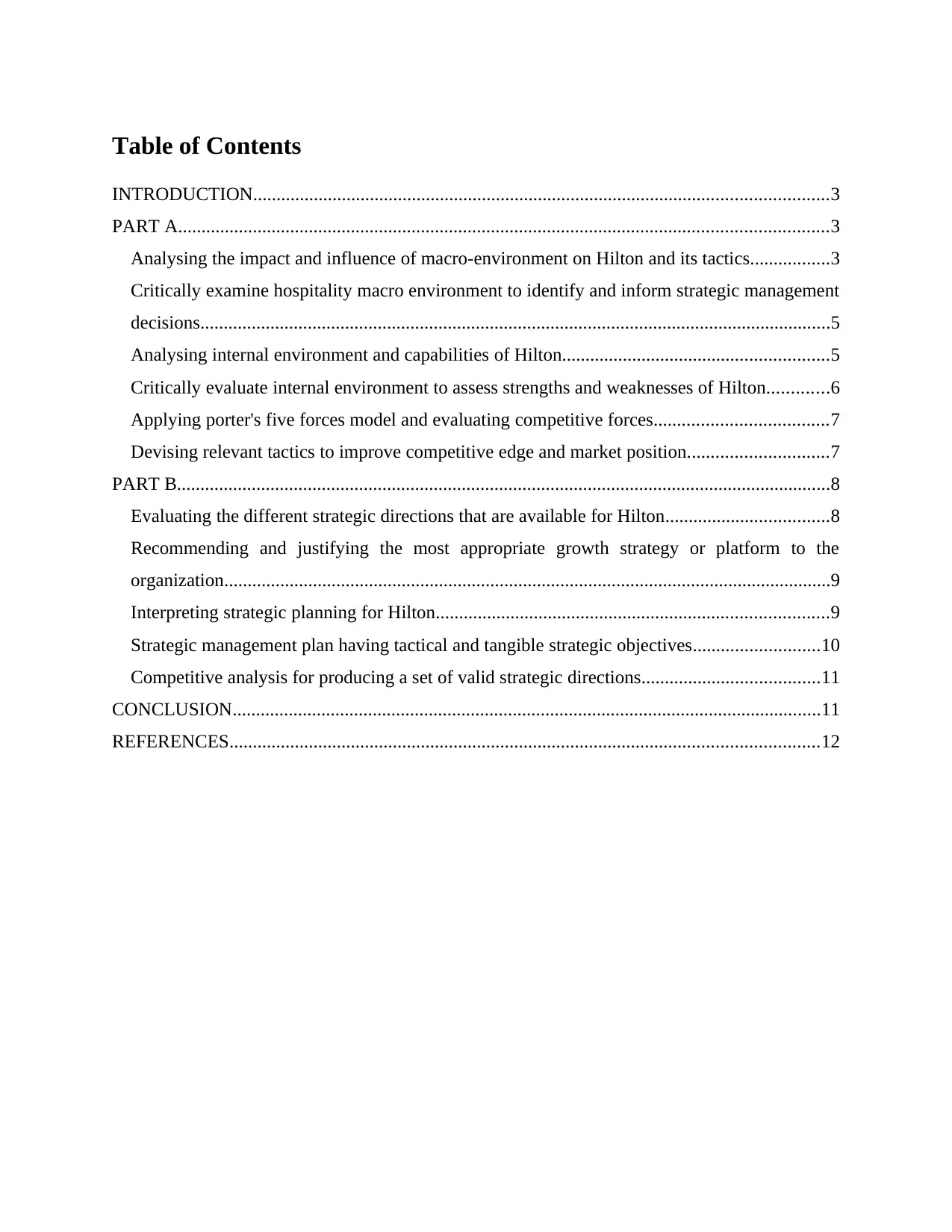
Table of Contents
INTRODUCTION...........................................................................................................................3
PART A...........................................................................................................................................3
Analysing the impact and influence of macro-environment on Hilton and its tactics.................3
Critically examine hospitality macro environment to identify and inform strategic management
decisions.......................................................................................................................................5
Analysing internal environment and capabilities of Hilton.........................................................5
Critically evaluate internal environment to assess strengths and weaknesses of Hilton.............6
Applying porter's five forces model and evaluating competitive forces.....................................7
Devising relevant tactics to improve competitive edge and market position..............................7
PART B............................................................................................................................................8
Evaluating the different strategic directions that are available for Hilton...................................8
Recommending and justifying the most appropriate growth strategy or platform to the
organization..................................................................................................................................9
Interpreting strategic planning for Hilton....................................................................................9
Strategic management plan having tactical and tangible strategic objectives...........................10
Competitive analysis for producing a set of valid strategic directions......................................11
CONCLUSION..............................................................................................................................11
REFERENCES..............................................................................................................................12
INTRODUCTION...........................................................................................................................3
PART A...........................................................................................................................................3
Analysing the impact and influence of macro-environment on Hilton and its tactics.................3
Critically examine hospitality macro environment to identify and inform strategic management
decisions.......................................................................................................................................5
Analysing internal environment and capabilities of Hilton.........................................................5
Critically evaluate internal environment to assess strengths and weaknesses of Hilton.............6
Applying porter's five forces model and evaluating competitive forces.....................................7
Devising relevant tactics to improve competitive edge and market position..............................7
PART B............................................................................................................................................8
Evaluating the different strategic directions that are available for Hilton...................................8
Recommending and justifying the most appropriate growth strategy or platform to the
organization..................................................................................................................................9
Interpreting strategic planning for Hilton....................................................................................9
Strategic management plan having tactical and tangible strategic objectives...........................10
Competitive analysis for producing a set of valid strategic directions......................................11
CONCLUSION..............................................................................................................................11
REFERENCES..............................................................................................................................12
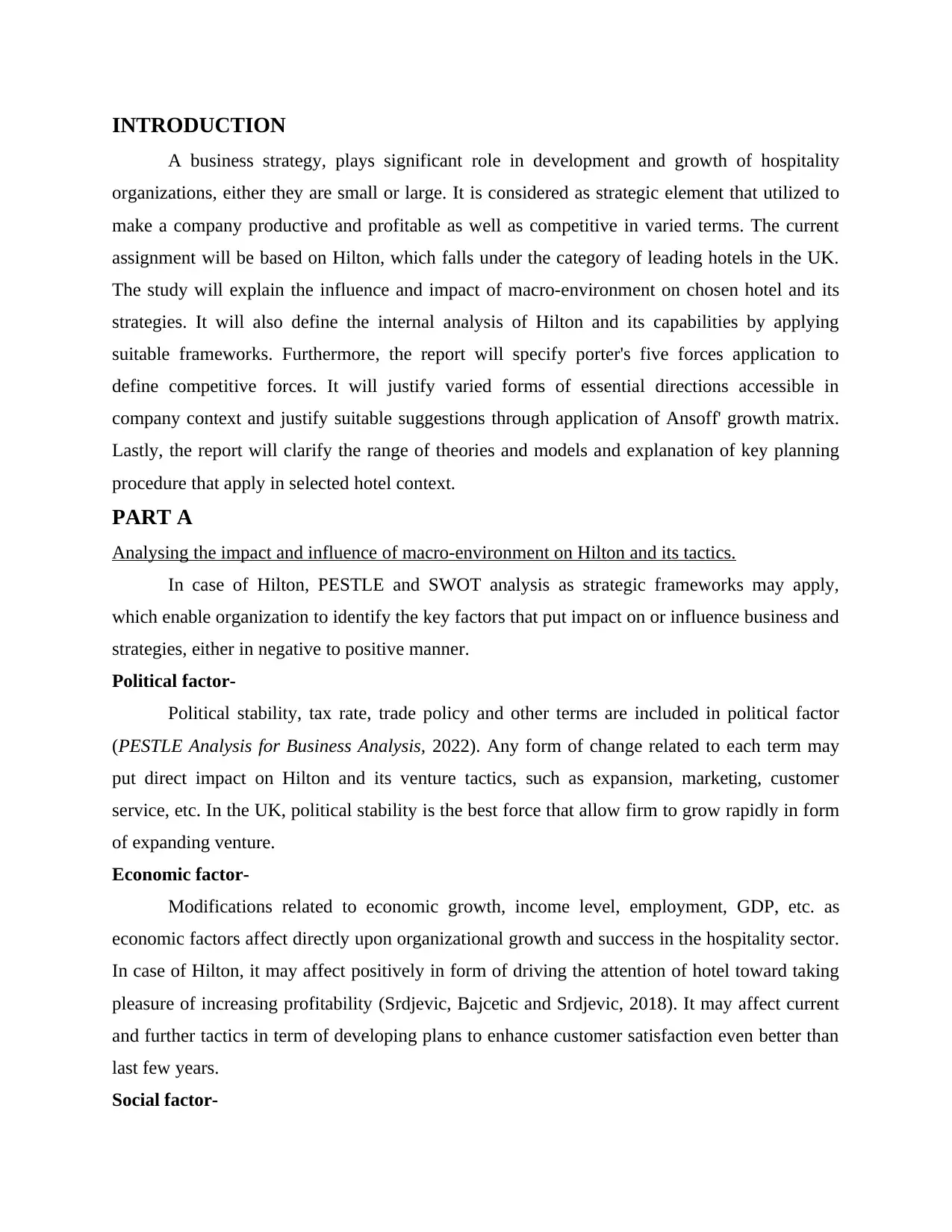
INTRODUCTION
A business strategy, plays significant role in development and growth of hospitality
organizations, either they are small or large. It is considered as strategic element that utilized to
make a company productive and profitable as well as competitive in varied terms. The current
assignment will be based on Hilton, which falls under the category of leading hotels in the UK.
The study will explain the influence and impact of macro-environment on chosen hotel and its
strategies. It will also define the internal analysis of Hilton and its capabilities by applying
suitable frameworks. Furthermore, the report will specify porter's five forces application to
define competitive forces. It will justify varied forms of essential directions accessible in
company context and justify suitable suggestions through application of Ansoff' growth matrix.
Lastly, the report will clarify the range of theories and models and explanation of key planning
procedure that apply in selected hotel context.
PART A
Analysing the impact and influence of macro-environment on Hilton and its tactics.
In case of Hilton, PESTLE and SWOT analysis as strategic frameworks may apply,
which enable organization to identify the key factors that put impact on or influence business and
strategies, either in negative to positive manner.
Political factor-
Political stability, tax rate, trade policy and other terms are included in political factor
(PESTLE Analysis for Business Analysis, 2022). Any form of change related to each term may
put direct impact on Hilton and its venture tactics, such as expansion, marketing, customer
service, etc. In the UK, political stability is the best force that allow firm to grow rapidly in form
of expanding venture.
Economic factor-
Modifications related to economic growth, income level, employment, GDP, etc. as
economic factors affect directly upon organizational growth and success in the hospitality sector.
In case of Hilton, it may affect positively in form of driving the attention of hotel toward taking
pleasure of increasing profitability (Srdjevic, Bajcetic and Srdjevic, 2018). It may affect current
and further tactics in term of developing plans to enhance customer satisfaction even better than
last few years.
Social factor-
A business strategy, plays significant role in development and growth of hospitality
organizations, either they are small or large. It is considered as strategic element that utilized to
make a company productive and profitable as well as competitive in varied terms. The current
assignment will be based on Hilton, which falls under the category of leading hotels in the UK.
The study will explain the influence and impact of macro-environment on chosen hotel and its
strategies. It will also define the internal analysis of Hilton and its capabilities by applying
suitable frameworks. Furthermore, the report will specify porter's five forces application to
define competitive forces. It will justify varied forms of essential directions accessible in
company context and justify suitable suggestions through application of Ansoff' growth matrix.
Lastly, the report will clarify the range of theories and models and explanation of key planning
procedure that apply in selected hotel context.
PART A
Analysing the impact and influence of macro-environment on Hilton and its tactics.
In case of Hilton, PESTLE and SWOT analysis as strategic frameworks may apply,
which enable organization to identify the key factors that put impact on or influence business and
strategies, either in negative to positive manner.
Political factor-
Political stability, tax rate, trade policy and other terms are included in political factor
(PESTLE Analysis for Business Analysis, 2022). Any form of change related to each term may
put direct impact on Hilton and its venture tactics, such as expansion, marketing, customer
service, etc. In the UK, political stability is the best force that allow firm to grow rapidly in form
of expanding venture.
Economic factor-
Modifications related to economic growth, income level, employment, GDP, etc. as
economic factors affect directly upon organizational growth and success in the hospitality sector.
In case of Hilton, it may affect positively in form of driving the attention of hotel toward taking
pleasure of increasing profitability (Srdjevic, Bajcetic and Srdjevic, 2018). It may affect current
and further tactics in term of developing plans to enhance customer satisfaction even better than
last few years.
Social factor-
⊘ This is a preview!⊘
Do you want full access?
Subscribe today to unlock all pages.

Trusted by 1+ million students worldwide
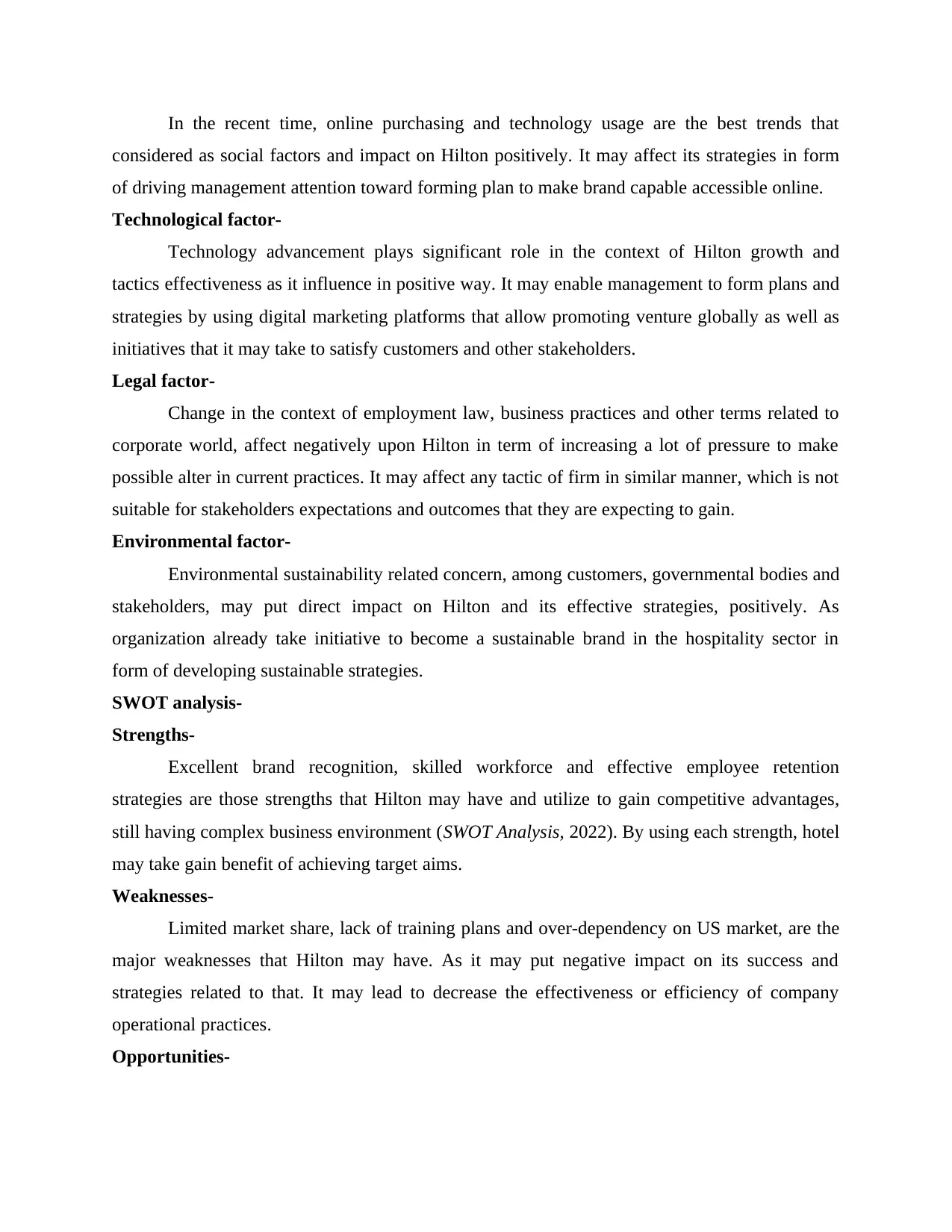
In the recent time, online purchasing and technology usage are the best trends that
considered as social factors and impact on Hilton positively. It may affect its strategies in form
of driving management attention toward forming plan to make brand capable accessible online.
Technological factor-
Technology advancement plays significant role in the context of Hilton growth and
tactics effectiveness as it influence in positive way. It may enable management to form plans and
strategies by using digital marketing platforms that allow promoting venture globally as well as
initiatives that it may take to satisfy customers and other stakeholders.
Legal factor-
Change in the context of employment law, business practices and other terms related to
corporate world, affect negatively upon Hilton in term of increasing a lot of pressure to make
possible alter in current practices. It may affect any tactic of firm in similar manner, which is not
suitable for stakeholders expectations and outcomes that they are expecting to gain.
Environmental factor-
Environmental sustainability related concern, among customers, governmental bodies and
stakeholders, may put direct impact on Hilton and its effective strategies, positively. As
organization already take initiative to become a sustainable brand in the hospitality sector in
form of developing sustainable strategies.
SWOT analysis-
Strengths-
Excellent brand recognition, skilled workforce and effective employee retention
strategies are those strengths that Hilton may have and utilize to gain competitive advantages,
still having complex business environment (SWOT Analysis, 2022). By using each strength, hotel
may take gain benefit of achieving target aims.
Weaknesses-
Limited market share, lack of training plans and over-dependency on US market, are the
major weaknesses that Hilton may have. As it may put negative impact on its success and
strategies related to that. It may lead to decrease the effectiveness or efficiency of company
operational practices.
Opportunities-
considered as social factors and impact on Hilton positively. It may affect its strategies in form
of driving management attention toward forming plan to make brand capable accessible online.
Technological factor-
Technology advancement plays significant role in the context of Hilton growth and
tactics effectiveness as it influence in positive way. It may enable management to form plans and
strategies by using digital marketing platforms that allow promoting venture globally as well as
initiatives that it may take to satisfy customers and other stakeholders.
Legal factor-
Change in the context of employment law, business practices and other terms related to
corporate world, affect negatively upon Hilton in term of increasing a lot of pressure to make
possible alter in current practices. It may affect any tactic of firm in similar manner, which is not
suitable for stakeholders expectations and outcomes that they are expecting to gain.
Environmental factor-
Environmental sustainability related concern, among customers, governmental bodies and
stakeholders, may put direct impact on Hilton and its effective strategies, positively. As
organization already take initiative to become a sustainable brand in the hospitality sector in
form of developing sustainable strategies.
SWOT analysis-
Strengths-
Excellent brand recognition, skilled workforce and effective employee retention
strategies are those strengths that Hilton may have and utilize to gain competitive advantages,
still having complex business environment (SWOT Analysis, 2022). By using each strength, hotel
may take gain benefit of achieving target aims.
Weaknesses-
Limited market share, lack of training plans and over-dependency on US market, are the
major weaknesses that Hilton may have. As it may put negative impact on its success and
strategies related to that. It may lead to decrease the effectiveness or efficiency of company
operational practices.
Opportunities-
Paraphrase This Document
Need a fresh take? Get an instant paraphrase of this document with our AI Paraphraser
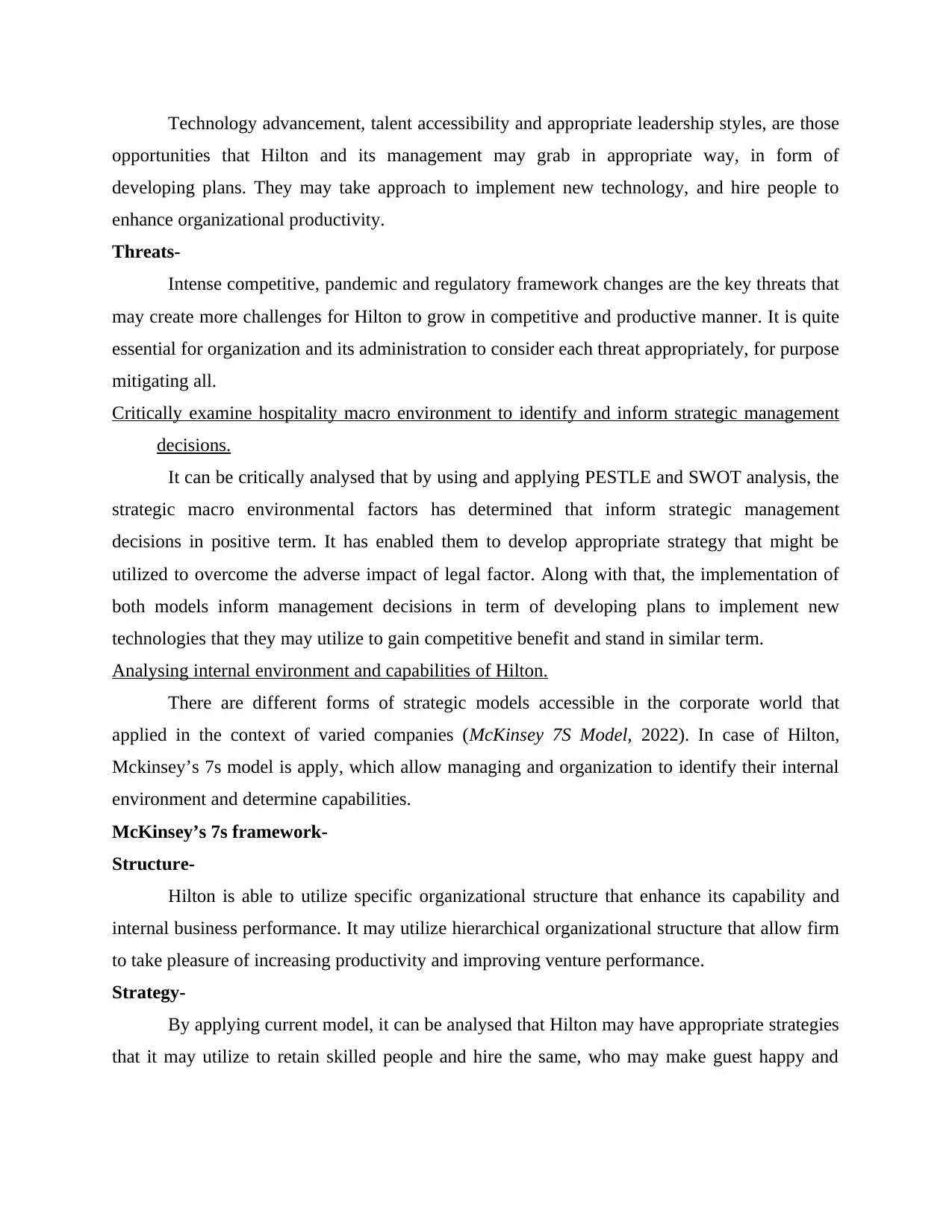
Technology advancement, talent accessibility and appropriate leadership styles, are those
opportunities that Hilton and its management may grab in appropriate way, in form of
developing plans. They may take approach to implement new technology, and hire people to
enhance organizational productivity.
Threats-
Intense competitive, pandemic and regulatory framework changes are the key threats that
may create more challenges for Hilton to grow in competitive and productive manner. It is quite
essential for organization and its administration to consider each threat appropriately, for purpose
mitigating all.
Critically examine hospitality macro environment to identify and inform strategic management
decisions.
It can be critically analysed that by using and applying PESTLE and SWOT analysis, the
strategic macro environmental factors has determined that inform strategic management
decisions in positive term. It has enabled them to develop appropriate strategy that might be
utilized to overcome the adverse impact of legal factor. Along with that, the implementation of
both models inform management decisions in term of developing plans to implement new
technologies that they may utilize to gain competitive benefit and stand in similar term.
Analysing internal environment and capabilities of Hilton.
There are different forms of strategic models accessible in the corporate world that
applied in the context of varied companies (McKinsey 7S Model, 2022). In case of Hilton,
Mckinsey’s 7s model is apply, which allow managing and organization to identify their internal
environment and determine capabilities.
McKinsey’s 7s framework-
Structure-
Hilton is able to utilize specific organizational structure that enhance its capability and
internal business performance. It may utilize hierarchical organizational structure that allow firm
to take pleasure of increasing productivity and improving venture performance.
Strategy-
By applying current model, it can be analysed that Hilton may have appropriate strategies
that it may utilize to retain skilled people and hire the same, who may make guest happy and
opportunities that Hilton and its management may grab in appropriate way, in form of
developing plans. They may take approach to implement new technology, and hire people to
enhance organizational productivity.
Threats-
Intense competitive, pandemic and regulatory framework changes are the key threats that
may create more challenges for Hilton to grow in competitive and productive manner. It is quite
essential for organization and its administration to consider each threat appropriately, for purpose
mitigating all.
Critically examine hospitality macro environment to identify and inform strategic management
decisions.
It can be critically analysed that by using and applying PESTLE and SWOT analysis, the
strategic macro environmental factors has determined that inform strategic management
decisions in positive term. It has enabled them to develop appropriate strategy that might be
utilized to overcome the adverse impact of legal factor. Along with that, the implementation of
both models inform management decisions in term of developing plans to implement new
technologies that they may utilize to gain competitive benefit and stand in similar term.
Analysing internal environment and capabilities of Hilton.
There are different forms of strategic models accessible in the corporate world that
applied in the context of varied companies (McKinsey 7S Model, 2022). In case of Hilton,
Mckinsey’s 7s model is apply, which allow managing and organization to identify their internal
environment and determine capabilities.
McKinsey’s 7s framework-
Structure-
Hilton is able to utilize specific organizational structure that enhance its capability and
internal business performance. It may utilize hierarchical organizational structure that allow firm
to take pleasure of increasing productivity and improving venture performance.
Strategy-
By applying current model, it can be analysed that Hilton may have appropriate strategies
that it may utilize to retain skilled people and hire the same, who may make guest happy and
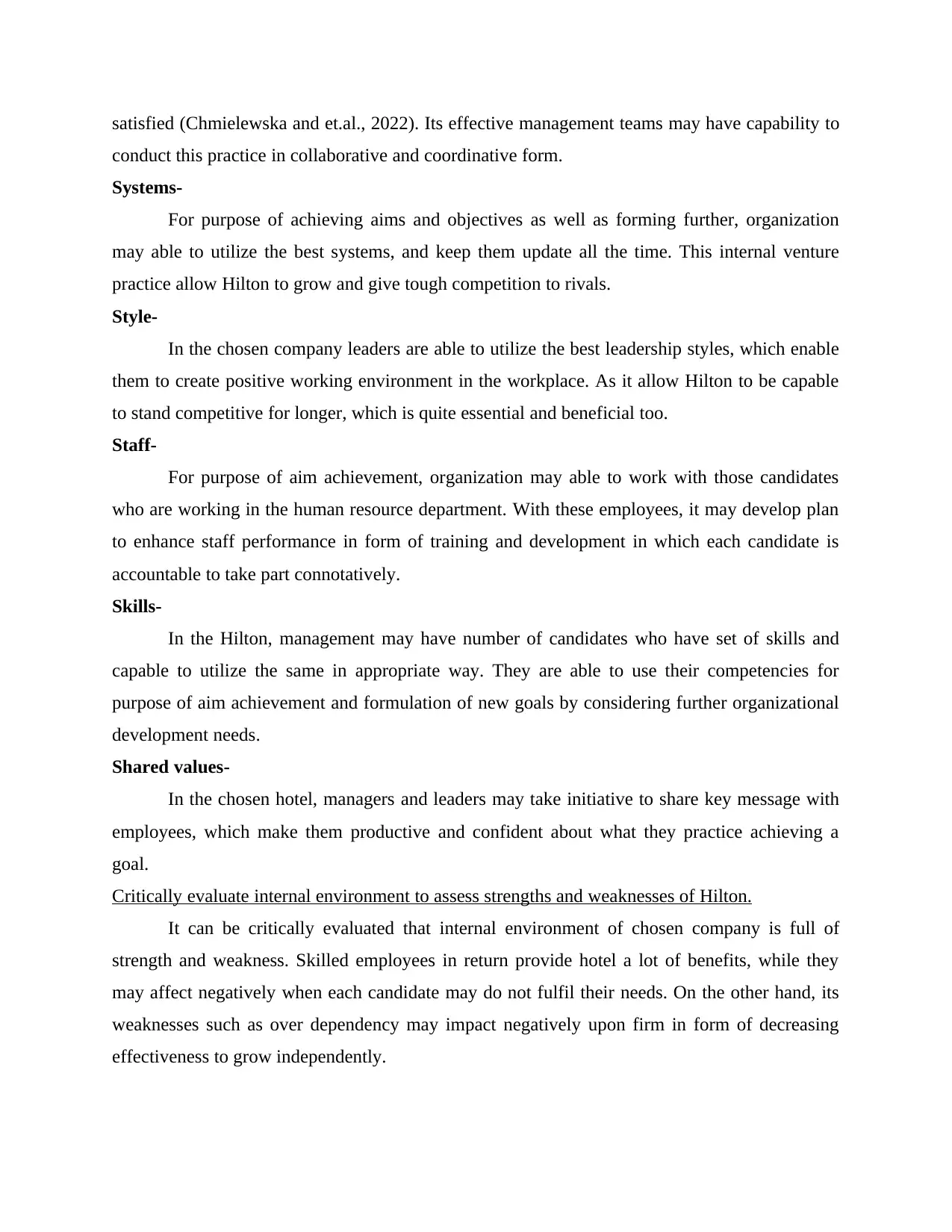
satisfied (Chmielewska and et.al., 2022). Its effective management teams may have capability to
conduct this practice in collaborative and coordinative form.
Systems-
For purpose of achieving aims and objectives as well as forming further, organization
may able to utilize the best systems, and keep them update all the time. This internal venture
practice allow Hilton to grow and give tough competition to rivals.
Style-
In the chosen company leaders are able to utilize the best leadership styles, which enable
them to create positive working environment in the workplace. As it allow Hilton to be capable
to stand competitive for longer, which is quite essential and beneficial too.
Staff-
For purpose of aim achievement, organization may able to work with those candidates
who are working in the human resource department. With these employees, it may develop plan
to enhance staff performance in form of training and development in which each candidate is
accountable to take part connotatively.
Skills-
In the Hilton, management may have number of candidates who have set of skills and
capable to utilize the same in appropriate way. They are able to use their competencies for
purpose of aim achievement and formulation of new goals by considering further organizational
development needs.
Shared values-
In the chosen hotel, managers and leaders may take initiative to share key message with
employees, which make them productive and confident about what they practice achieving a
goal.
Critically evaluate internal environment to assess strengths and weaknesses of Hilton.
It can be critically evaluated that internal environment of chosen company is full of
strength and weakness. Skilled employees in return provide hotel a lot of benefits, while they
may affect negatively when each candidate may do not fulfil their needs. On the other hand, its
weaknesses such as over dependency may impact negatively upon firm in form of decreasing
effectiveness to grow independently.
conduct this practice in collaborative and coordinative form.
Systems-
For purpose of achieving aims and objectives as well as forming further, organization
may able to utilize the best systems, and keep them update all the time. This internal venture
practice allow Hilton to grow and give tough competition to rivals.
Style-
In the chosen company leaders are able to utilize the best leadership styles, which enable
them to create positive working environment in the workplace. As it allow Hilton to be capable
to stand competitive for longer, which is quite essential and beneficial too.
Staff-
For purpose of aim achievement, organization may able to work with those candidates
who are working in the human resource department. With these employees, it may develop plan
to enhance staff performance in form of training and development in which each candidate is
accountable to take part connotatively.
Skills-
In the Hilton, management may have number of candidates who have set of skills and
capable to utilize the same in appropriate way. They are able to use their competencies for
purpose of aim achievement and formulation of new goals by considering further organizational
development needs.
Shared values-
In the chosen hotel, managers and leaders may take initiative to share key message with
employees, which make them productive and confident about what they practice achieving a
goal.
Critically evaluate internal environment to assess strengths and weaknesses of Hilton.
It can be critically evaluated that internal environment of chosen company is full of
strength and weakness. Skilled employees in return provide hotel a lot of benefits, while they
may affect negatively when each candidate may do not fulfil their needs. On the other hand, its
weaknesses such as over dependency may impact negatively upon firm in form of decreasing
effectiveness to grow independently.
⊘ This is a preview!⊘
Do you want full access?
Subscribe today to unlock all pages.

Trusted by 1+ million students worldwide
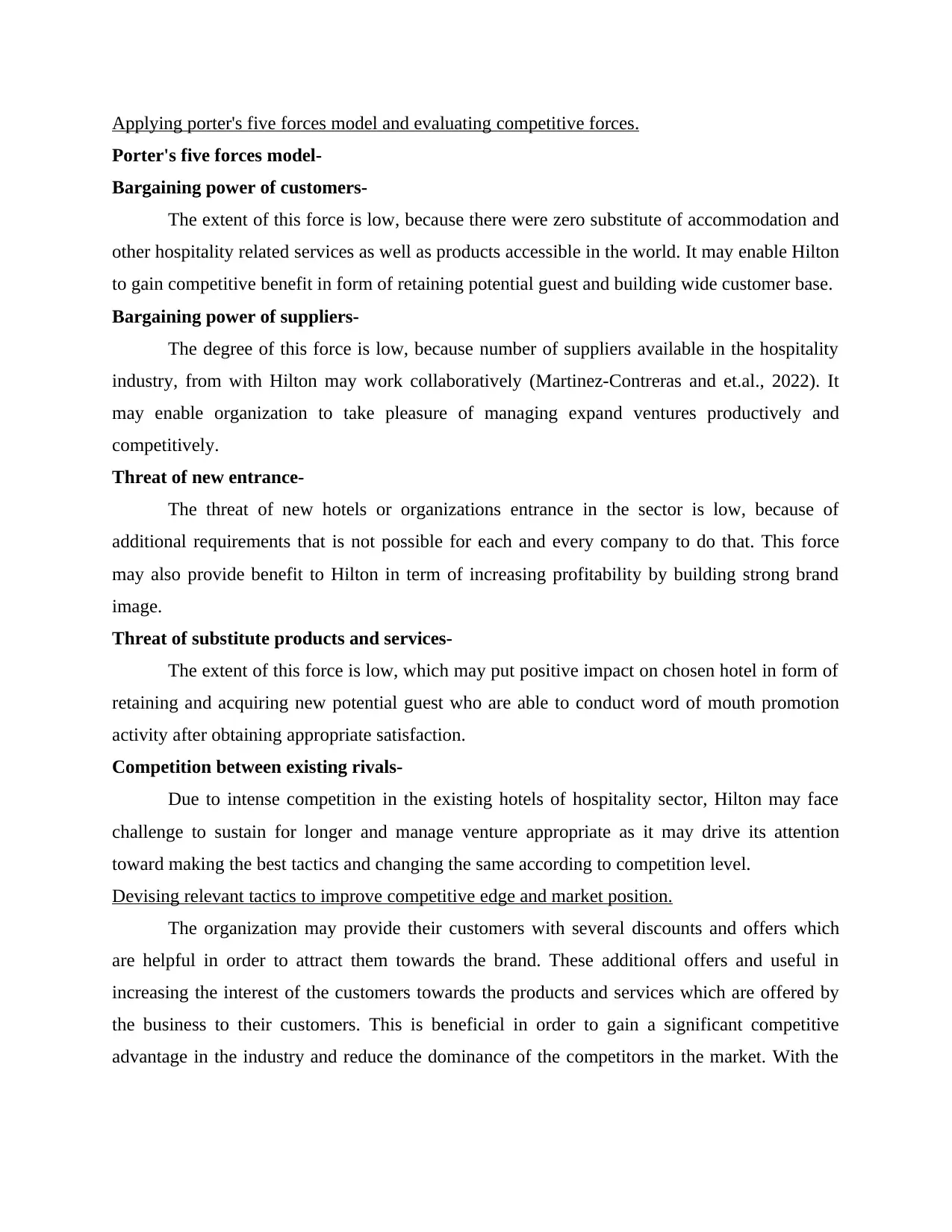
Applying porter's five forces model and evaluating competitive forces.
Porter's five forces model-
Bargaining power of customers-
The extent of this force is low, because there were zero substitute of accommodation and
other hospitality related services as well as products accessible in the world. It may enable Hilton
to gain competitive benefit in form of retaining potential guest and building wide customer base.
Bargaining power of suppliers-
The degree of this force is low, because number of suppliers available in the hospitality
industry, from with Hilton may work collaboratively (Martinez-Contreras and et.al., 2022). It
may enable organization to take pleasure of managing expand ventures productively and
competitively.
Threat of new entrance-
The threat of new hotels or organizations entrance in the sector is low, because of
additional requirements that is not possible for each and every company to do that. This force
may also provide benefit to Hilton in term of increasing profitability by building strong brand
image.
Threat of substitute products and services-
The extent of this force is low, which may put positive impact on chosen hotel in form of
retaining and acquiring new potential guest who are able to conduct word of mouth promotion
activity after obtaining appropriate satisfaction.
Competition between existing rivals-
Due to intense competition in the existing hotels of hospitality sector, Hilton may face
challenge to sustain for longer and manage venture appropriate as it may drive its attention
toward making the best tactics and changing the same according to competition level.
Devising relevant tactics to improve competitive edge and market position.
The organization may provide their customers with several discounts and offers which
are helpful in order to attract them towards the brand. These additional offers and useful in
increasing the interest of the customers towards the products and services which are offered by
the business to their customers. This is beneficial in order to gain a significant competitive
advantage in the industry and reduce the dominance of the competitors in the market. With the
Porter's five forces model-
Bargaining power of customers-
The extent of this force is low, because there were zero substitute of accommodation and
other hospitality related services as well as products accessible in the world. It may enable Hilton
to gain competitive benefit in form of retaining potential guest and building wide customer base.
Bargaining power of suppliers-
The degree of this force is low, because number of suppliers available in the hospitality
industry, from with Hilton may work collaboratively (Martinez-Contreras and et.al., 2022). It
may enable organization to take pleasure of managing expand ventures productively and
competitively.
Threat of new entrance-
The threat of new hotels or organizations entrance in the sector is low, because of
additional requirements that is not possible for each and every company to do that. This force
may also provide benefit to Hilton in term of increasing profitability by building strong brand
image.
Threat of substitute products and services-
The extent of this force is low, which may put positive impact on chosen hotel in form of
retaining and acquiring new potential guest who are able to conduct word of mouth promotion
activity after obtaining appropriate satisfaction.
Competition between existing rivals-
Due to intense competition in the existing hotels of hospitality sector, Hilton may face
challenge to sustain for longer and manage venture appropriate as it may drive its attention
toward making the best tactics and changing the same according to competition level.
Devising relevant tactics to improve competitive edge and market position.
The organization may provide their customers with several discounts and offers which
are helpful in order to attract them towards the brand. These additional offers and useful in
increasing the interest of the customers towards the products and services which are offered by
the business to their customers. This is beneficial in order to gain a significant competitive
advantage in the industry and reduce the dominance of the competitors in the market. With the
Paraphrase This Document
Need a fresh take? Get an instant paraphrase of this document with our AI Paraphraser
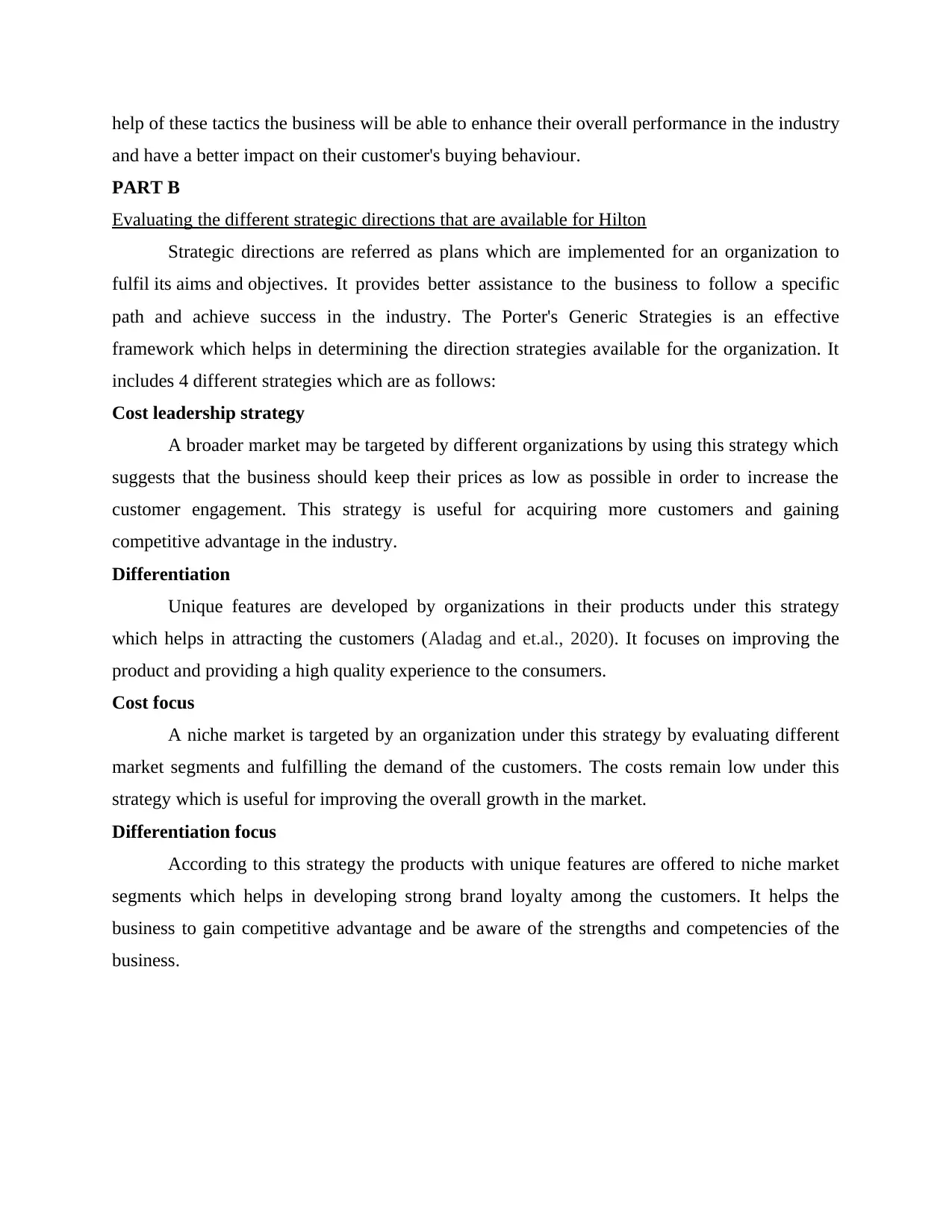
help of these tactics the business will be able to enhance their overall performance in the industry
and have a better impact on their customer's buying behaviour.
PART B
Evaluating the different strategic directions that are available for Hilton
Strategic directions are referred as plans which are implemented for an organization to
fulfil its aims and objectives. It provides better assistance to the business to follow a specific
path and achieve success in the industry. The Porter's Generic Strategies is an effective
framework which helps in determining the direction strategies available for the organization. It
includes 4 different strategies which are as follows:
Cost leadership strategy
A broader market may be targeted by different organizations by using this strategy which
suggests that the business should keep their prices as low as possible in order to increase the
customer engagement. This strategy is useful for acquiring more customers and gaining
competitive advantage in the industry.
Differentiation
Unique features are developed by organizations in their products under this strategy
which helps in attracting the customers (Aladag and et.al., 2020). It focuses on improving the
product and providing a high quality experience to the consumers.
Cost focus
A niche market is targeted by an organization under this strategy by evaluating different
market segments and fulfilling the demand of the customers. The costs remain low under this
strategy which is useful for improving the overall growth in the market.
Differentiation focus
According to this strategy the products with unique features are offered to niche market
segments which helps in developing strong brand loyalty among the customers. It helps the
business to gain competitive advantage and be aware of the strengths and competencies of the
business.
and have a better impact on their customer's buying behaviour.
PART B
Evaluating the different strategic directions that are available for Hilton
Strategic directions are referred as plans which are implemented for an organization to
fulfil its aims and objectives. It provides better assistance to the business to follow a specific
path and achieve success in the industry. The Porter's Generic Strategies is an effective
framework which helps in determining the direction strategies available for the organization. It
includes 4 different strategies which are as follows:
Cost leadership strategy
A broader market may be targeted by different organizations by using this strategy which
suggests that the business should keep their prices as low as possible in order to increase the
customer engagement. This strategy is useful for acquiring more customers and gaining
competitive advantage in the industry.
Differentiation
Unique features are developed by organizations in their products under this strategy
which helps in attracting the customers (Aladag and et.al., 2020). It focuses on improving the
product and providing a high quality experience to the consumers.
Cost focus
A niche market is targeted by an organization under this strategy by evaluating different
market segments and fulfilling the demand of the customers. The costs remain low under this
strategy which is useful for improving the overall growth in the market.
Differentiation focus
According to this strategy the products with unique features are offered to niche market
segments which helps in developing strong brand loyalty among the customers. It helps the
business to gain competitive advantage and be aware of the strengths and competencies of the
business.
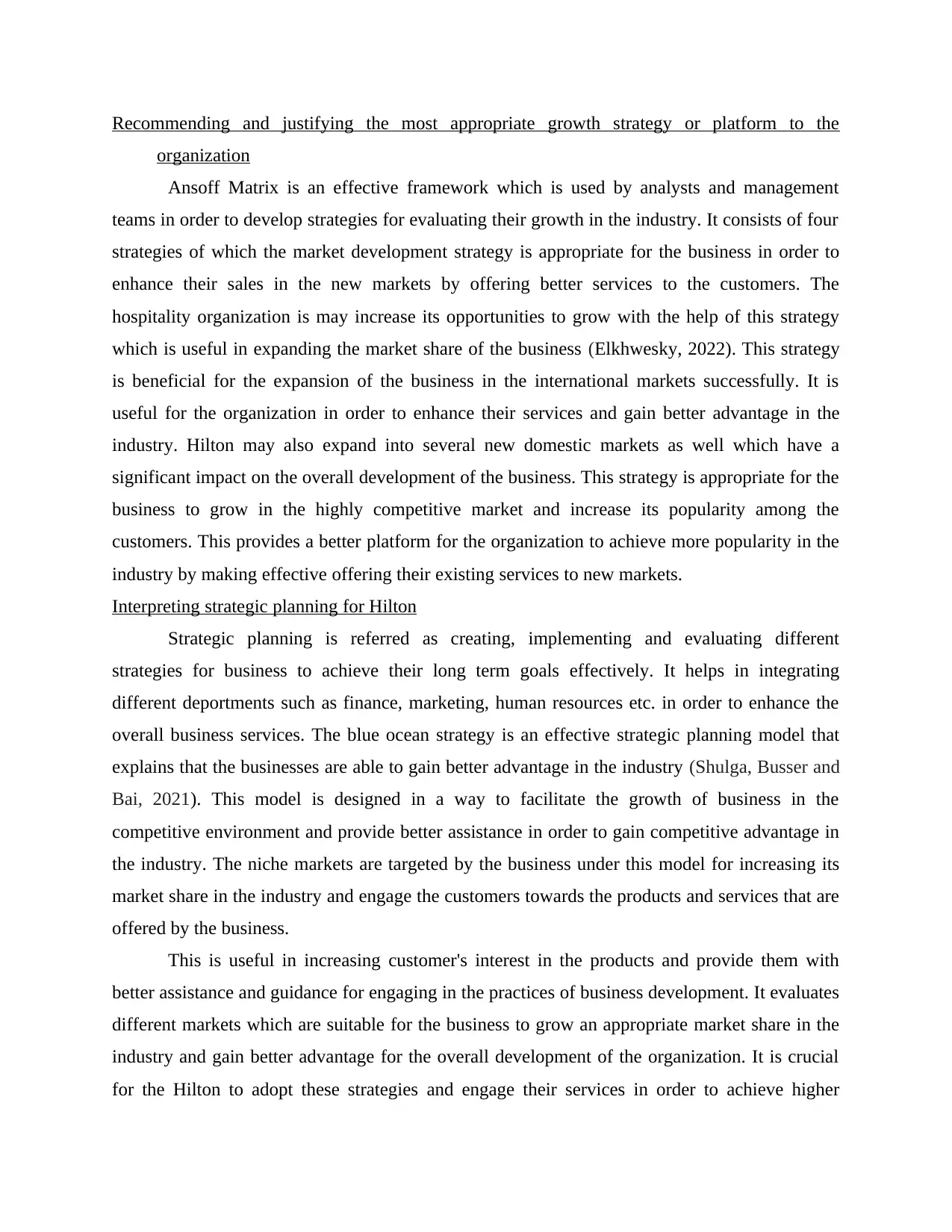
Recommending and justifying the most appropriate growth strategy or platform to the
organization
Ansoff Matrix is an effective framework which is used by analysts and management
teams in order to develop strategies for evaluating their growth in the industry. It consists of four
strategies of which the market development strategy is appropriate for the business in order to
enhance their sales in the new markets by offering better services to the customers. The
hospitality organization is may increase its opportunities to grow with the help of this strategy
which is useful in expanding the market share of the business (Elkhwesky, 2022). This strategy
is beneficial for the expansion of the business in the international markets successfully. It is
useful for the organization in order to enhance their services and gain better advantage in the
industry. Hilton may also expand into several new domestic markets as well which have a
significant impact on the overall development of the business. This strategy is appropriate for the
business to grow in the highly competitive market and increase its popularity among the
customers. This provides a better platform for the organization to achieve more popularity in the
industry by making effective offering their existing services to new markets.
Interpreting strategic planning for Hilton
Strategic planning is referred as creating, implementing and evaluating different
strategies for business to achieve their long term goals effectively. It helps in integrating
different deportments such as finance, marketing, human resources etc. in order to enhance the
overall business services. The blue ocean strategy is an effective strategic planning model that
explains that the businesses are able to gain better advantage in the industry (Shulga, Busser and
Bai, 2021). This model is designed in a way to facilitate the growth of business in the
competitive environment and provide better assistance in order to gain competitive advantage in
the industry. The niche markets are targeted by the business under this model for increasing its
market share in the industry and engage the customers towards the products and services that are
offered by the business.
This is useful in increasing customer's interest in the products and provide them with
better assistance and guidance for engaging in the practices of business development. It evaluates
different markets which are suitable for the business to grow an appropriate market share in the
industry and gain better advantage for the overall development of the organization. It is crucial
for the Hilton to adopt these strategies and engage their services in order to achieve higher
organization
Ansoff Matrix is an effective framework which is used by analysts and management
teams in order to develop strategies for evaluating their growth in the industry. It consists of four
strategies of which the market development strategy is appropriate for the business in order to
enhance their sales in the new markets by offering better services to the customers. The
hospitality organization is may increase its opportunities to grow with the help of this strategy
which is useful in expanding the market share of the business (Elkhwesky, 2022). This strategy
is beneficial for the expansion of the business in the international markets successfully. It is
useful for the organization in order to enhance their services and gain better advantage in the
industry. Hilton may also expand into several new domestic markets as well which have a
significant impact on the overall development of the business. This strategy is appropriate for the
business to grow in the highly competitive market and increase its popularity among the
customers. This provides a better platform for the organization to achieve more popularity in the
industry by making effective offering their existing services to new markets.
Interpreting strategic planning for Hilton
Strategic planning is referred as creating, implementing and evaluating different
strategies for business to achieve their long term goals effectively. It helps in integrating
different deportments such as finance, marketing, human resources etc. in order to enhance the
overall business services. The blue ocean strategy is an effective strategic planning model that
explains that the businesses are able to gain better advantage in the industry (Shulga, Busser and
Bai, 2021). This model is designed in a way to facilitate the growth of business in the
competitive environment and provide better assistance in order to gain competitive advantage in
the industry. The niche markets are targeted by the business under this model for increasing its
market share in the industry and engage the customers towards the products and services that are
offered by the business.
This is useful in increasing customer's interest in the products and provide them with
better assistance and guidance for engaging in the practices of business development. It evaluates
different markets which are suitable for the business to grow an appropriate market share in the
industry and gain better advantage for the overall development of the organization. It is crucial
for the Hilton to adopt these strategies and engage their services in order to achieve higher
⊘ This is a preview!⊘
Do you want full access?
Subscribe today to unlock all pages.

Trusted by 1+ million students worldwide
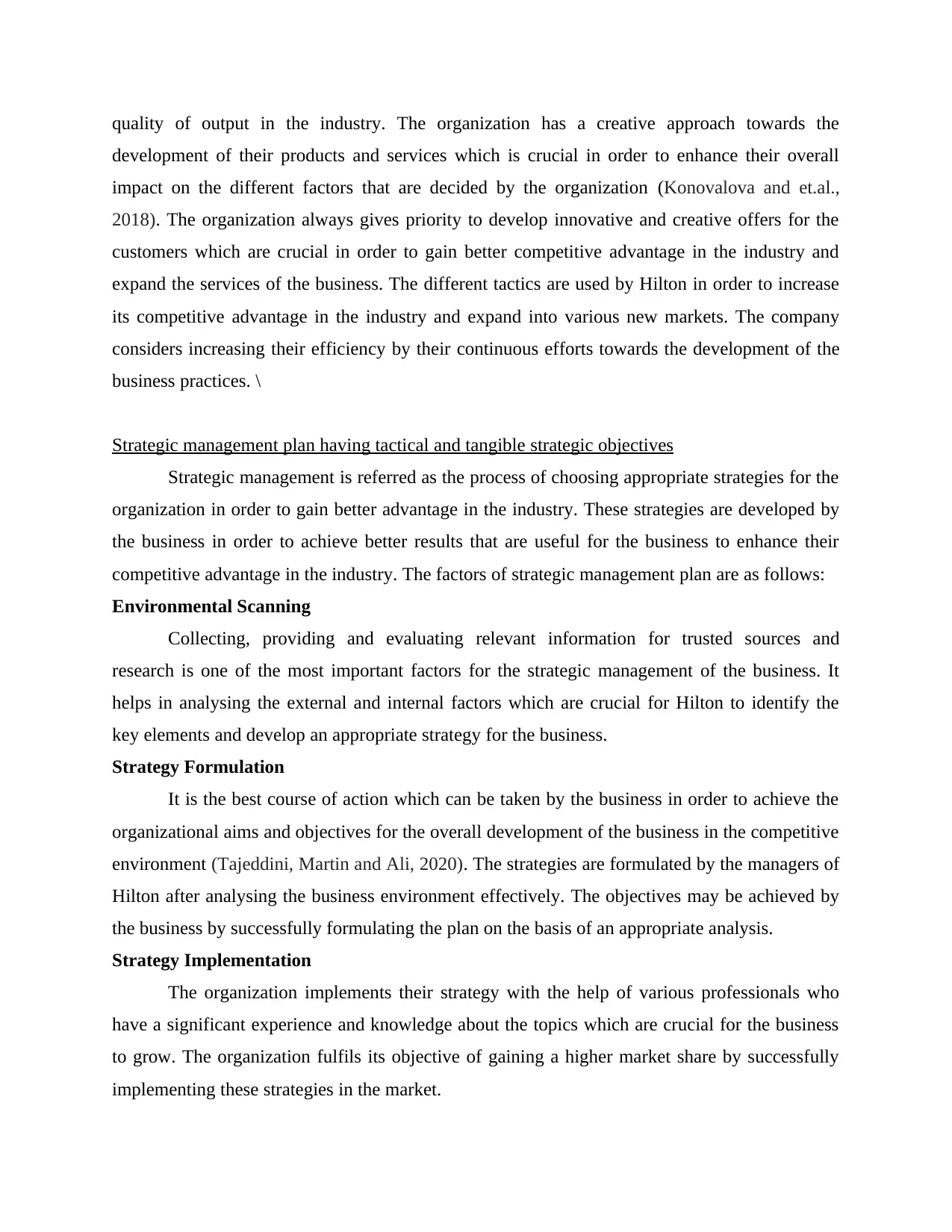
quality of output in the industry. The organization has a creative approach towards the
development of their products and services which is crucial in order to enhance their overall
impact on the different factors that are decided by the organization (Konovalova and et.al.,
2018). The organization always gives priority to develop innovative and creative offers for the
customers which are crucial in order to gain better competitive advantage in the industry and
expand the services of the business. The different tactics are used by Hilton in order to increase
its competitive advantage in the industry and expand into various new markets. The company
considers increasing their efficiency by their continuous efforts towards the development of the
business practices. \
Strategic management plan having tactical and tangible strategic objectives
Strategic management is referred as the process of choosing appropriate strategies for the
organization in order to gain better advantage in the industry. These strategies are developed by
the business in order to achieve better results that are useful for the business to enhance their
competitive advantage in the industry. The factors of strategic management plan are as follows:
Environmental Scanning
Collecting, providing and evaluating relevant information for trusted sources and
research is one of the most important factors for the strategic management of the business. It
helps in analysing the external and internal factors which are crucial for Hilton to identify the
key elements and develop an appropriate strategy for the business.
Strategy Formulation
It is the best course of action which can be taken by the business in order to achieve the
organizational aims and objectives for the overall development of the business in the competitive
environment (Tajeddini, Martin and Ali, 2020). The strategies are formulated by the managers of
Hilton after analysing the business environment effectively. The objectives may be achieved by
the business by successfully formulating the plan on the basis of an appropriate analysis.
Strategy Implementation
The organization implements their strategy with the help of various professionals who
have a significant experience and knowledge about the topics which are crucial for the business
to grow. The organization fulfils its objective of gaining a higher market share by successfully
implementing these strategies in the market.
development of their products and services which is crucial in order to enhance their overall
impact on the different factors that are decided by the organization (Konovalova and et.al.,
2018). The organization always gives priority to develop innovative and creative offers for the
customers which are crucial in order to gain better competitive advantage in the industry and
expand the services of the business. The different tactics are used by Hilton in order to increase
its competitive advantage in the industry and expand into various new markets. The company
considers increasing their efficiency by their continuous efforts towards the development of the
business practices. \
Strategic management plan having tactical and tangible strategic objectives
Strategic management is referred as the process of choosing appropriate strategies for the
organization in order to gain better advantage in the industry. These strategies are developed by
the business in order to achieve better results that are useful for the business to enhance their
competitive advantage in the industry. The factors of strategic management plan are as follows:
Environmental Scanning
Collecting, providing and evaluating relevant information for trusted sources and
research is one of the most important factors for the strategic management of the business. It
helps in analysing the external and internal factors which are crucial for Hilton to identify the
key elements and develop an appropriate strategy for the business.
Strategy Formulation
It is the best course of action which can be taken by the business in order to achieve the
organizational aims and objectives for the overall development of the business in the competitive
environment (Tajeddini, Martin and Ali, 2020). The strategies are formulated by the managers of
Hilton after analysing the business environment effectively. The objectives may be achieved by
the business by successfully formulating the plan on the basis of an appropriate analysis.
Strategy Implementation
The organization implements their strategy with the help of various professionals who
have a significant experience and knowledge about the topics which are crucial for the business
to grow. The organization fulfils its objective of gaining a higher market share by successfully
implementing these strategies in the market.
Paraphrase This Document
Need a fresh take? Get an instant paraphrase of this document with our AI Paraphraser
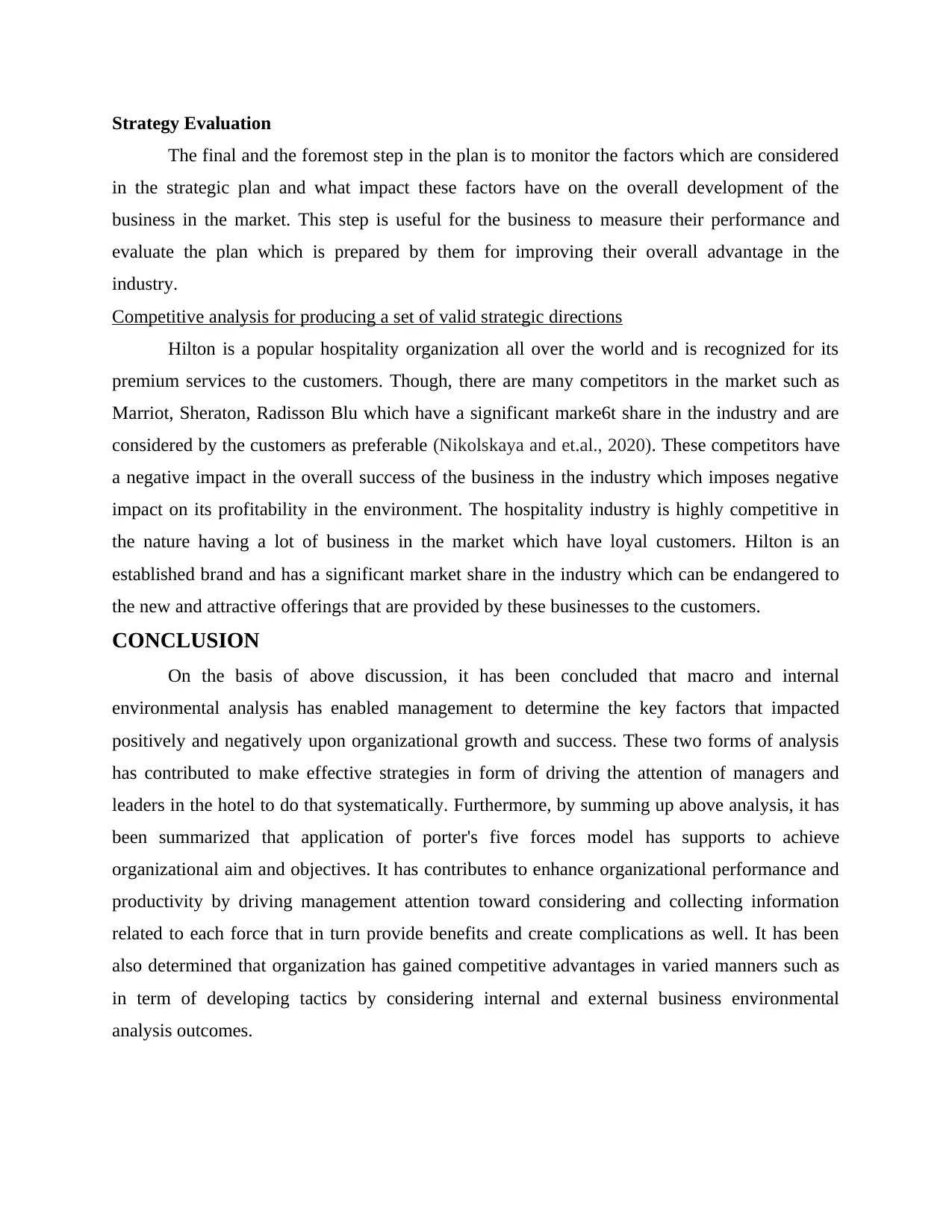
Strategy Evaluation
The final and the foremost step in the plan is to monitor the factors which are considered
in the strategic plan and what impact these factors have on the overall development of the
business in the market. This step is useful for the business to measure their performance and
evaluate the plan which is prepared by them for improving their overall advantage in the
industry.
Competitive analysis for producing a set of valid strategic directions
Hilton is a popular hospitality organization all over the world and is recognized for its
premium services to the customers. Though, there are many competitors in the market such as
Marriot, Sheraton, Radisson Blu which have a significant marke6t share in the industry and are
considered by the customers as preferable (Nikolskaya and et.al., 2020). These competitors have
a negative impact in the overall success of the business in the industry which imposes negative
impact on its profitability in the environment. The hospitality industry is highly competitive in
the nature having a lot of business in the market which have loyal customers. Hilton is an
established brand and has a significant market share in the industry which can be endangered to
the new and attractive offerings that are provided by these businesses to the customers.
CONCLUSION
On the basis of above discussion, it has been concluded that macro and internal
environmental analysis has enabled management to determine the key factors that impacted
positively and negatively upon organizational growth and success. These two forms of analysis
has contributed to make effective strategies in form of driving the attention of managers and
leaders in the hotel to do that systematically. Furthermore, by summing up above analysis, it has
been summarized that application of porter's five forces model has supports to achieve
organizational aim and objectives. It has contributes to enhance organizational performance and
productivity by driving management attention toward considering and collecting information
related to each force that in turn provide benefits and create complications as well. It has been
also determined that organization has gained competitive advantages in varied manners such as
in term of developing tactics by considering internal and external business environmental
analysis outcomes.
The final and the foremost step in the plan is to monitor the factors which are considered
in the strategic plan and what impact these factors have on the overall development of the
business in the market. This step is useful for the business to measure their performance and
evaluate the plan which is prepared by them for improving their overall advantage in the
industry.
Competitive analysis for producing a set of valid strategic directions
Hilton is a popular hospitality organization all over the world and is recognized for its
premium services to the customers. Though, there are many competitors in the market such as
Marriot, Sheraton, Radisson Blu which have a significant marke6t share in the industry and are
considered by the customers as preferable (Nikolskaya and et.al., 2020). These competitors have
a negative impact in the overall success of the business in the industry which imposes negative
impact on its profitability in the environment. The hospitality industry is highly competitive in
the nature having a lot of business in the market which have loyal customers. Hilton is an
established brand and has a significant market share in the industry which can be endangered to
the new and attractive offerings that are provided by these businesses to the customers.
CONCLUSION
On the basis of above discussion, it has been concluded that macro and internal
environmental analysis has enabled management to determine the key factors that impacted
positively and negatively upon organizational growth and success. These two forms of analysis
has contributed to make effective strategies in form of driving the attention of managers and
leaders in the hotel to do that systematically. Furthermore, by summing up above analysis, it has
been summarized that application of porter's five forces model has supports to achieve
organizational aim and objectives. It has contributes to enhance organizational performance and
productivity by driving management attention toward considering and collecting information
related to each force that in turn provide benefits and create complications as well. It has been
also determined that organization has gained competitive advantages in varied manners such as
in term of developing tactics by considering internal and external business environmental
analysis outcomes.
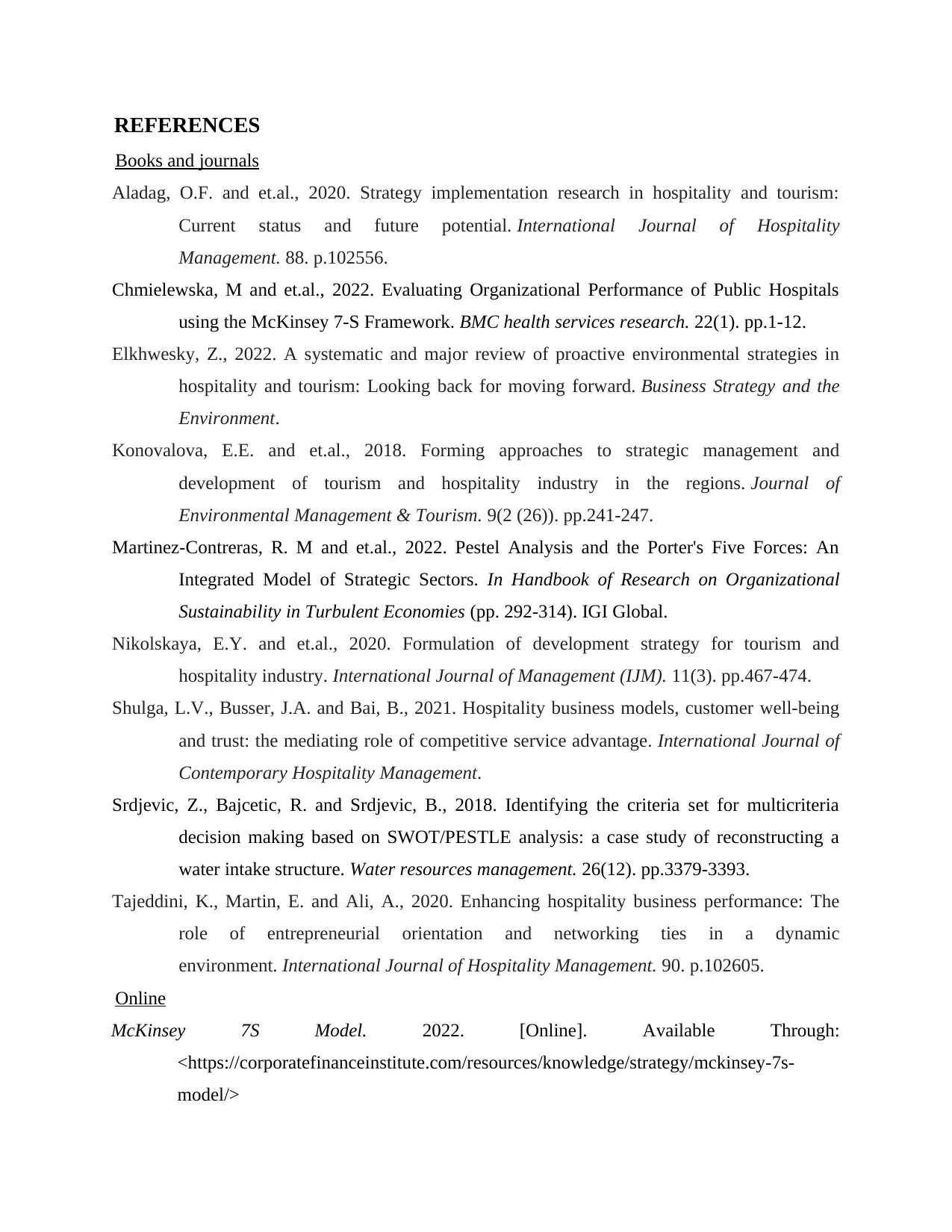
REFERENCES
Books and journals
Aladag, O.F. and et.al., 2020. Strategy implementation research in hospitality and tourism:
Current status and future potential. International Journal of Hospitality
Management. 88. p.102556.
Chmielewska, M and et.al., 2022. Evaluating Organizational Performance of Public Hospitals
using the McKinsey 7-S Framework. BMC health services research. 22(1). pp.1-12.
Elkhwesky, Z., 2022. A systematic and major review of proactive environmental strategies in
hospitality and tourism: Looking back for moving forward. Business Strategy and the
Environment.
Konovalova, E.E. and et.al., 2018. Forming approaches to strategic management and
development of tourism and hospitality industry in the regions. Journal of
Environmental Management & Tourism. 9(2 (26)). pp.241-247.
Martinez-Contreras, R. M and et.al., 2022. Pestel Analysis and the Porter's Five Forces: An
Integrated Model of Strategic Sectors. In Handbook of Research on Organizational
Sustainability in Turbulent Economies (pp. 292-314). IGI Global.
Nikolskaya, E.Y. and et.al., 2020. Formulation of development strategy for tourism and
hospitality industry. International Journal of Management (IJM). 11(3). pp.467-474.
Shulga, L.V., Busser, J.A. and Bai, B., 2021. Hospitality business models, customer well-being
and trust: the mediating role of competitive service advantage. International Journal of
Contemporary Hospitality Management.
Srdjevic, Z., Bajcetic, R. and Srdjevic, B., 2018. Identifying the criteria set for multicriteria
decision making based on SWOT/PESTLE analysis: a case study of reconstructing a
water intake structure. Water resources management. 26(12). pp.3379-3393.
Tajeddini, K., Martin, E. and Ali, A., 2020. Enhancing hospitality business performance: The
role of entrepreneurial orientation and networking ties in a dynamic
environment. International Journal of Hospitality Management. 90. p.102605.
Online
McKinsey 7S Model. 2022. [Online]. Available Through:
<https://corporatefinanceinstitute.com/resources/knowledge/strategy/mckinsey-7s-
model/>
Books and journals
Aladag, O.F. and et.al., 2020. Strategy implementation research in hospitality and tourism:
Current status and future potential. International Journal of Hospitality
Management. 88. p.102556.
Chmielewska, M and et.al., 2022. Evaluating Organizational Performance of Public Hospitals
using the McKinsey 7-S Framework. BMC health services research. 22(1). pp.1-12.
Elkhwesky, Z., 2022. A systematic and major review of proactive environmental strategies in
hospitality and tourism: Looking back for moving forward. Business Strategy and the
Environment.
Konovalova, E.E. and et.al., 2018. Forming approaches to strategic management and
development of tourism and hospitality industry in the regions. Journal of
Environmental Management & Tourism. 9(2 (26)). pp.241-247.
Martinez-Contreras, R. M and et.al., 2022. Pestel Analysis and the Porter's Five Forces: An
Integrated Model of Strategic Sectors. In Handbook of Research on Organizational
Sustainability in Turbulent Economies (pp. 292-314). IGI Global.
Nikolskaya, E.Y. and et.al., 2020. Formulation of development strategy for tourism and
hospitality industry. International Journal of Management (IJM). 11(3). pp.467-474.
Shulga, L.V., Busser, J.A. and Bai, B., 2021. Hospitality business models, customer well-being
and trust: the mediating role of competitive service advantage. International Journal of
Contemporary Hospitality Management.
Srdjevic, Z., Bajcetic, R. and Srdjevic, B., 2018. Identifying the criteria set for multicriteria
decision making based on SWOT/PESTLE analysis: a case study of reconstructing a
water intake structure. Water resources management. 26(12). pp.3379-3393.
Tajeddini, K., Martin, E. and Ali, A., 2020. Enhancing hospitality business performance: The
role of entrepreneurial orientation and networking ties in a dynamic
environment. International Journal of Hospitality Management. 90. p.102605.
Online
McKinsey 7S Model. 2022. [Online]. Available Through:
<https://corporatefinanceinstitute.com/resources/knowledge/strategy/mckinsey-7s-
model/>
⊘ This is a preview!⊘
Do you want full access?
Subscribe today to unlock all pages.

Trusted by 1+ million students worldwide
1 out of 13
Related Documents
Your All-in-One AI-Powered Toolkit for Academic Success.
+13062052269
info@desklib.com
Available 24*7 on WhatsApp / Email
![[object Object]](/_next/static/media/star-bottom.7253800d.svg)
Unlock your academic potential
Copyright © 2020–2025 A2Z Services. All Rights Reserved. Developed and managed by ZUCOL.

